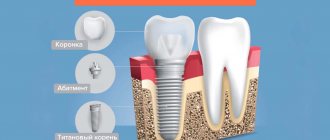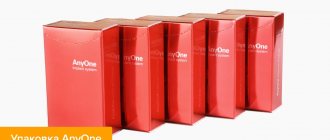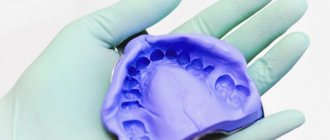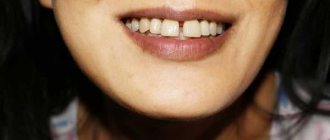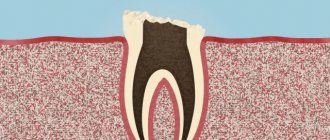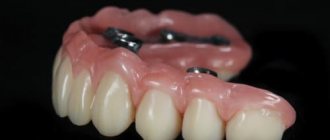Dental prosthetics using implants is a dental procedure in which a structure is implanted into the structure of the bone tissue, completely replicating the structure of the lost unit. One of the important elements of the system is the abutment, which acts as a connecting link between the artificial rod and the crown. The stability of the prosthesis depends on the quality of the connection, the task of which is to correctly distribute the chewing load on the jaw row. Among the options offered by manufacturers, the multiunit abutment deserves special attention, the features and advantages of which we will consider in this review.
Abutment design and purpose
The word “abutment” translated from English means “support”. Previously, this concept was used to refer to the patient's natural tooth supporting the artificial crown of a bridge. But with the advent of implantation, they began to give it a different meaning, namely, support for a prosthesis.
An abutment in implantation today is a special superstructure, an intermediate or connecting link between the dental implant, which is located in the jawbone, and the top of the tooth - the crown. It is a periosteal element on which a structure is fixed that replaces the crown of a lost tooth. A single prosthesis, a bridge or a removable system can be attached to it. In essence, the product is an adapter. You can see what the abutment looks like in the photo below.
The term “suprastructure” is usually used to refer to all elements of the implantation system that allow prosthetics to be performed on implants - plugs, screws, fasteners and abutments themselves.
It is important not to confuse it with another superstructure - the gum former. This is a temporary element that is used only in classical two-stage implantation and is needed to form a beautiful gum contour around the titanium root and heal the soft tissues. It is installed for several weeks, and then changed to the required type of support element. And it can also be abutments (but temporary), but if the role of the shaper is played by a lightweight (also temporary) dental crown, which is attached to the implant immediately after its implantation.
DENTAL PROSTHESIS WITH 4 OSSTEM IMPLANTS - RUB 170,000!
Implantation even with bone tissue atrophy. Work guarantee! Save RUR 20,000.
on promotion >> Free consultation with an implantologist +7 (495) 215-52-31 or write to us
General overview
MultiUnit fixators are intended for point and complete restoration of the maxillary region - the design provides for the possibility of installing single dentures, as well as conditionally removable structures that replace the entire row. Products are included in complete all-on-4 and all-on-6 systems and can be used in conjunction with inclined artificial pins.
Molded structures, the structure of which includes MultiUnit abutments, belong to the category of conditionally removable prostheses, which allows the system to be freely dismantled for repair or correction, without the risk of damage to the pin. Popular models include straight and angular clamps that compensate for the divergence angle of implants from 40 to 100 degrees.
Classification of models - advantages and disadvantages of each type
In modern dentistry, high-quality solutions are created thanks to innovative technologies. Each implant manufacturer has product lines that include not only implants, but also superstructures, instruments, and biomaterials. Support elements can differ in size (diameter, length and height), angle of inclination, type of platform (narrow, standard and wide), shape, material and even installation method. Below we will consider in detail the different types of abutments.
Very often, doctors offer to install an abutment, which is produced by another company (for example, Korean), and is conditionally suitable for all implants. This option should be abandoned. The implant and superstructure that are installed on the patient must be original and come from the same manufacturer. Otherwise, they may not have perfect contact with each other - the gaps may be microscopic and completely invisible to the naked eye. But even this will be enough for the development of complications, up to complete rejection of the implants due to overload from the abutment and prosthesis.
Classic or stamped models
This is the most common option; in another way, such products are also called stamped, because. they are manufactured at all implant manufacturing plants exclusively for their own products. The models are universal, have a standard shape, and are created mainly from titanium, less often from alloys of other metals or zirconium dioxide. They differ in height, diameter, and tilt options relative to the root (20º–45º). Suitable for a large number of patients, have an affordable price, because... The production of such abutments is maximally optimized, thought out, load-tested and automated.
In general, it is standard products that are the most popular and optimal in all respects. They, of course, have their drawbacks, but, in fact, there are still no alternatives - individual systems are not at all aimed at long-term functioning (we will explain why below).
Disadvantages of traditional superstructures:
- Sometimes there are problems with aesthetics: such products are most often created from metal, which has a gray tint. Therefore, in the frontal area, the support can be seen through the thin veneering material of the crowns. In addition, over time, the gums will definitely sag, so the structure may become noticeable, or it will be visible through the gums (at the point of contact with the gum crown it will “darken”). However, this is an inevitable fact and the most important thing is to monitor hygiene and regularly visit a doctor to correct this situation,
- sometimes the standard model cannot be applied in complex situations: here you really have to develop an individual system. But this may only be relevant when restoring the front teeth and is not acceptable for the side teeth, which bear an increased chewing load.
- Sometimes problems may arise when fixing the prosthesis with cement: some models do not have a ledge at the base, so if the crown is attached with cement, the liquid material can simply “fill” the space around the installed implant. Especially if the doctor did not select the concentration or amount of the product correctly. If there is a ledge, then the cement remains exclusively above it (i.e., within the coronal part) and does not fall under the mucosa. In addition, screw-retained models are increasingly being used today as a more effective alternative (read more about this type below).
The success of using any elements of the system largely depends on the professionalism of the doctor. So, a specialist needs to correctly select the correct angle of inclination and size from all the options for standard “connectors”, because An adapter that is too large or, on the contrary, small, simply will not allow you to achieve high-quality prosthetics. It is also possible to overload the root, which can lead to failure of the entire system.
Models created individually for each patient
Such a detail is already created exclusively for the bite characteristics of a particular patient. To make it, after implantation of the implant, the doctor takes impressions, then a prototype of the future model is created, the information is scanned and, using 3D technologies and CAD/CAM equipment, the dental technician develops an individual support for the crown. Everything takes no more than one week, and the end result is a product that allows you to achieve fairly high aesthetic standards. Also, individual models have a small ledge, which prevents cement from getting under the gum when installing them.
Materials for creating individual superstructures:
- Zirconium dioxide: used even more often than titanium. When individualizing treatment, the emphasis is most often on aesthetics, and zirconium dioxide (like ceramics) is white. This means that the product will not show through the crown, will not cause the gums to turn blue at the point of contact with the mucous membrane, but at the same time will be characterized by increased strength and hypoallergenicity,
- titanium or its alloy with aluminum and vanadium: such a product can be partially lined with ceramics to improve aesthetics,
- ceramics: which can be given any shade,
- gold plating.
There is such a thing as a “zirconium abutment”. But here it is important to understand the differences between the two materials: zirconium is a metal, but zirconium dioxide is no longer. It is white in color and bioinert - it does not cause allergic reactions, is extremely durable and is even comparable in hardness to many metals.
At first glance, it may seem that individual superstructures are better than template ones. But that's not true. Custom ones are created in a regular dental laboratory rather than in a manufacturing plant. And the dental technician physically does not have the opportunity to conduct multiple tests for functional load, which means it is completely unclear what pressure the superstructures will ultimately be able to withstand. That is why this option is not suitable for the lateral teeth with which we chew.
Read on the topic: everything about individual abutments in one article - manufacturing features, advantages and disadvantages.
There is a similar question regarding implants - will such supports really correctly distribute pressure on the intraosseous part of the system? It is important to understand that at the factory all elements of the system undergo a huge number of tests. And if the question is only about aesthetics, then today almost all manufacturers produce supporting superstructures created from snow-white zirconium dioxide - these are not individual, but standard, i.e. template models.
Temporary structure
The temporary abutment is made of plastic, less often of titanium (cheap MIS[1] implants and premium Nobel models have these). It serves as a temporary adapter between the implant and the adaptation prosthesis, which is installed immediately after implantation of artificial roots. For wearing a crown or simply taking impressions. They can also be used for the period of fitting and correction of permanent prosthetic products. These models are lightweight, aesthetic, but at the same time quite durable and inexpensive.
Ball-shaped systems
At the top they have the shape of a sphere, for which special recesses are created in the inner part of the prosthesis. Suitable for installing conditionally removable and removable dentures. This form of fastening helps patients not to think about dentures falling out of their mouth at the most inopportune moment. But it is very short-lived and can quickly fail, since it is not designed for strong mechanical loads. After a few years, such supports are subject to natural wear and need to be replaced. Moreover, sometimes it is necessary to change not only the superstructure, but also the implant.
For conditionally removable prosthetics, some manufacturing companies supply superstructures that work using the Locator system. These are unique solutions that, compared to spherical systems, have a flat base and provide the patient with easy, reliable fixation and removal of dentures. Essentially they work like buttons. They are more wear-resistant and last several times longer than spherical ones.
Also, some manufacturers supply products of the OT Equator type for removable prosthetics on implants, which are miniature in size and coated with titanium nitride, which increases wear resistance.
Direct superstructures
Most of the models currently in use have exactly this structure. Straight products are made both with and without a shoulder; they can have different neck heights for connection to the implant - 1, 2, 3, 4 millimeters. Designed primarily for the restoration of anterior teeth located in the smile zone, where implants are inserted strictly vertically.
Corner models
They have a certain axis tilt (usually 17° or 30°), which allows the dental crown to be placed directly on the implant if it is installed at an angle. Most often, such abutments are used for complex dental implantation. As a rule, we are talking about lateral areas, in which, due to the anatomy and unevenness of bone tissue atrophy, it is necessary to find the optimal solution for implantation. Installation of implants into the bone at an angle is necessary in the following situations:
- to bypass the sinuses and nerves,
- to use the most dense and sterile tissues: for better fixation of implants, installation is carried out in the buttresses of the skull - thickenings or force lines of the maxillary and zygomatic bones.
Thus, with the help of angular support components, the doctor is able to align the position of the crown or prosthetic device itself - so that they look as beautiful as possible and are comfortable to use.
Dental implantation using the Osstem system = 18,500 rubles. until January 15, 2022!
All inclusive, treatment guaranteed!
Premium implants at an affordable price. Free consultation with an implantologist +7 (495) 215-52-31 or write to us
Multiunit-abas are designed for reliable fixation of crowns or any other prostheses using a screw fastening system. They are multi-component structures, and due to the presence of a screw, they allow you to secure a crown or prosthesis so that, if necessary, it can be easily removed without sawing the entire system. Such abutments can be either straight or angular - a specific model is used depending on the situation.
Cast system integral with the implant
Monolithic models, where the abutment is connected to the dental implant at the production stage, are called one-piece. Essentially, it is just a one-piece implant that has no boundaries between the abutment and the intraosseous part. This allows dental implantation to be performed in just one visit to the doctor, which significantly reduces treatment time and also minimizes tissue trauma. A single-component type of implant is used mainly for one-stage implantation protocols, which involve immediate loading with the prosthesis.
The International Implant Foundation, based on numerous studies, has concluded that one-piece implants significantly reduce the likelihood of developing peri-implantitis and inflammation of the soft tissue around them. Thanks to the tightness, there is no risk of gaps and crevices forming between the components, into which pathogenic bacteria and plaque can enter. The connecting thread of such implants does not weaken during operation.
In order to prevent peri-implantitis, experienced doctors advise choosing either one-piece implant models (important in complex clinical cases with generalized periodontitis or periodontal disease) or two-piece types of implants with a polished neck-apex. Also suitable are models that have a smooth antibacterial coating on which plaque will not accumulate.
Multi-unit abutment
Key component of the All-on-4® treatment concept
Accuracy and ease of use from the developer
In 2000, Nobel Biocare developed the original Multi-unit abutment - at that time the first abutment of its type on the market. Since that time, it has become a recognized industry standard, and many manufacturers have attempted to copy its innovative design. The Multi-unit abutment differs from its analogues in those nuances that determine the success of prosthetics.
The Multi-unit abutment is designed for both full and partial restorations, and in particular for use in combination with the scientifically based and clinically proven All-on-4 ® treatment concept. 1-29
Carefully thought out design
- The short taper is ideal for limited interocclusal distances.
- The wide base of the abutment simplifies the installation of the prosthetic structure.
- For any gum type: straight and angled (17° and 30°) Multi-unit abutments have nine neck heights.
Simplicity and safety of operation
Each Multi-unit abutment comes with a pre-installed holder, making placement much easier. It also serves as a guide when checking the abutment angle.
Precision precision and aesthetics
Exceptionally accurate fit of fixed and semi-removable NobelProcera structures. A wide range of precision milled CAD/CAM designs, each carefully tested for compatibility and accurate fit with the Multi-unit abutment.
Multi-unit Plus Abutment
The Multi-unit Plus abutment for tapered implants takes the All-on-4 ® protocol to the next level. The Multi-unit Plus abutment is designed to significantly simplify and speed up temporary restorations.
Simplification of the temporary prosthetic protocol
The Temporary Snap Coping easily snaps onto the Multi-unit Plus Abutment and does not require the use of screws to secure the temporary restoration during try-in and preparation.
Save time in the clinic and laboratory
The new snap-on feature will help significantly reduce the time it takes to reline an existing prosthesis or create a new temporary structure.
Authenticity matters
A system is only as strong as its weakest link. The effectiveness of each individual component depends not only on its quality and design, but also on its interaction with the rest of the orthopedic system.
That's why we carry out tests and research both on the individual components and their interactions, and on the entire system they form.
Feedback from clinicians
Dr Rob Wain, UK
“I have been using Multi-unit abutments from Nobel Biocare for over ten years. I regularly use them both for All-on-4 ® treatment and for various clinical cases where it is necessary to compensate for the angle of the implant before installing a screw-retained prosthesis.
It is much more comfortable for both me and the patient to work at the soft tissue level, which allows me to perform prosthetics with a greater degree of confidence and safety. The long-term stability and success rates of the structures are excellent, and the easy access makes hygiene and care of the structure easier for the patient.”
Dr. Peter Wöhrle, USA
“The snap-on feature of the Multi-unit Plus abutment makes the integration of temporary copings into the temporary restoration much quicker and easier. This is important because treatment times are reduced, and even dentists with little experience can use this protocol with predictable results.”
Clinical cases
Dr. Paulo Maló, Portugal - All-on-4® Treatment Concept with NobelGuide
Clinical case:
female patient, 50 years old, completely edentulous, removable dentures on the upper and lower jaws installed more than 15 years ago.
Solution:
segmental rehabilitation of the upper jaw using fixed implant-supported structures and the All-on-4 ® treatment concept. The NobelGuide protocol (flapless technique) was used in the upper jaw, and the traditional All-on-4 ® flap technique was used in the lower jaw. High-precision NobelProcera implant-supported bridges were chosen as permanent structures in both the upper and lower jaws.
Dr. Rubén Davó, Spain – Complete rehabilitation for severe atrophy of the upper and lower jaw
Clinical case:
female patient, 60 years old, with severe bone resorption of the upper and lower jaw under a complete removable denture.
Solution:
For rehabilitation of the upper jaw, Brånemark System Zygoma and NobelReplace Tapered implants were used. The All-on-4 ® treatment concept was applied to the lower jaw. NobelProcera high-precision implant-supported bridges were chosen as the permanent structure in both the upper and lower jaws.
Literature
Multi-unit Abutment – Nobel Biocare
1. Malo P, de Araujo Nobre M, Lopes A. The use of computer-guided flapless implant surgery and four implants placed in immediate function to support a fixed denture: preliminary results after a mean follow-up period of thirteen months. J Prosthet Dent 2007;97(6 Suppl):26-34
2. Aparicio C, Perales, P, Rangert, B Tilted implants as an alternative to maxillary sinus grafting: a clinical, radiologic, and periotest study. Clin Implant Dent Related Res 2001; 3:39–49.
3. Abi Nader S, Eimar H, Momani, M. Plaque Accumulation Beneath Maxillary All-on-4 Implant-Supported Prostheses. Clin Implant Dent Relat Res 2014; epub ahead.
4. Agliardi E, Panigatti S, Clericò M, Villa C, Malò P. Immediate rehabilitation of the edentulous jaws with full fixed prostheses supported by four implants: interim results of a single cohort prospective study. Clin Oral Implants Res 2010; 21:459-655.
5. Antoun H, Belmon P, Cherfane P, Sitbon JM. Immediate loading of four or six implants in completely edentulous patients. Int J Periodontics Restorative Dent. 2012; 32(1):1-9.
6. Babbush C, Kutsko G, Brokloff J. The all-on-four immediate function treatment concept with NobelActive implants: a retrospective study. J Oral Implantol 2011;37:431-457.
7. Babbush C, Brokloff, J. A Single-Center Retrospective Analysis of 1001 Consecutively Placed NobelActive Implants. J Implant Dent 2012; 21(1): 28-35.
8. Baggi L, Pastore S, Di Girolamo M, Vairo G. Implant-bone load transfer mechanisms in complete-arch prostheses supported by four implants: A three-dimensional finite element approach, J Prosthet Dent 2013;109(1):9 -21
9. Butura CC, Galindo DF. Combined immediate loading of zygomatic and mandibular implants: a preliminary 2-year report of 19 patients. Int J Oral Maxillofac Implants 2014; 29(1): 22-29.
10. Butura CC, Galindo DF, Jensen OT. Mandibular all-on-four therapy using angled implants: a three-year clinical study of 857 implants in 219 jaws. Oral Maxillofac Surg Clin North Am 2011; 23(2): 289-300.
11. Cavalli N, Barbaro B, Spasari D. Tilted implants for full-arch rehabilitations in completely edentulous maxilla: a retrospective study. Int J Dent; ePub ahead 2012.
12. Francetti L, Agliardi E, Testori T. Immediate rehabilitation of the mandible with fixed full prosthesis supported by axial and tilted implants: interim results of a single cohort prospective study. Clin Implant Dent Relat Res 2008;10(4):255-263.
13. Francetti L, Romeo D, Corbella S, Taschieri S, Del Fabbro, M. Bone Level Changes Around Axial and Tilted Implants in Full-Arch Fixed Immediate Restorations. Interim Results of a Prospective Study. Clin Implant Dent Relat Res 2012; 14( 5):646-654.
14.Galindo DF, Butura CC. Immediately loaded mandibular fixed implant prostheses using the all-on-four protocol: a report of 183 consecutively treated patients with 1 year of function in definitive prostheses. Int J Oral Maxillofac Implants 2012; 27(3):628-633.
15. Gunaseelan R, Saravanakumar M, Hariharan R. Restoration of failing maxillary implant supported fixed prosthesis with cross arch splinted unilateral zygomatic implant: A Clinical Report. J Oral Implantol 2012;38(6):751-755.
16. Landazuri-Del Barrio RA, Cosyn J, De Paula WN, De Bruyn H, Marcantonio Jr E. A prospective study on implants installed with flapless-guided surgery using the all-on-four concept in the mandible. Clin Oral Implants Res 2013;24(4) 428-433.
17. Lopes A, Maló P, de Araújo Nobre M, Sanchez-Fernández E. The NobelGuide® All-on-4® Treatment Concept for Rehabilitation of Edentulous Jaws: A Prospective Report on Medium- and Long-Term Outcomes. Clin Implant Dent Relat Res 2014; 10.1111/cid.12260. .
18. Malo P, de Araujo Nobre M. A new approach for maxilla reconstruction. Eur J Oral Implantol 2009; 2(2):101-114.
19. Malo P, de Araujo Nobre M, Lopes A, Francischone C, Rigolizzo M. “All-on-4” Immediate-Function Concept for Completely Edentulous Maxillae: A Clinical Report on the Medium (3 Years) and Long-Term ( 5 Years) Outcomes. Clin Implant Dent Relat Res 2012;14 Suppl 1:139-150.
20. Malo P, de Araujo Nobre M, Lopes A, Moss SM, Molina GJ. A longitudinal study of the survival of All-on-4 implants in the mandible with up to 10 years of follow-up. J Am Dent Assoc 2011;142(3):310-320.
21. Malo P, de Sousa ST, De Araujo Nobre M. Individual Lithium Disilicate Crowns in a Full-Arch, Implant-Supported Rehabilitation: A Clinical Report. J Prosthodont 2014; ePub ahead.
22. Malo P, Nobre M, Lopes A, Francischone C, Rigolizzo, M. Three-year outcome of a retrospective cohort study on the rehabilitation of completely edentulous atrophic maxillae with immediately loaded extra-maxillary zygomatic implants. Eur J Oral Implantol 2012;5(1):37-46.
23. Malo P, Nobre M, Lopes A. Immediate Rehabilitation of Completely Edentulous Arches with a Four-Implant Prosthesis Concept in Difficult Conditions: An Open Cohort Study with a Mean Follow-up of 2 Years. Int J Oral Maxillofac Implants 2012;27(5):1177-1190.
24. Malo P, Rangert B, Nobre M. All-on-4 immediate-function concept with Branemark System implants for completely edentulous maxillae: a 1-year retrospective clinical study, Clin Implant Dent Relat Res 2005;7(Suppl 1): S88-S94, 2003-161
25. Mozzati M, Arata V, Gallesio G, Mussano F, Carossa S. Immediate Postextractive Dental Implant Placement with Immediate Loading on Four Implants for Mandibular-Full-Arch Rehabilitation: A Retrospective Analysis. Clin Implant Dent Relat Res 2013;15:332-40.
26. Puig CP. A retrospective study of edentulous patients rehabilitated according to the 'all-on-four' or the 'all-on-six' immediate function concept using flapless computer-guided implant surgery. Eur J Oral Implantol 2010;3(2):155-163.
27. Schroering R, Parrish K. Clinical protocol for rapid, graftless, four-implant restoration of the fully edentulous patient. Practical Procedures and Aesthetic Dentistry 2008; 29: supported by Nobel Biocare
28. Van Lierde, KM Browaeys H, Corthals P. Impact of fixed implant prosthetics using the 'all-on-four' treatment concept on speech intelligence, articulation and oromyofunctional behavior. Int J Oral Maxillofac Surg 2012; 41(12):1550–1557.
29. Weinstein R, Agliardi E, Fabbro MD, Romeo D, Francetti L. Immediate rehabilitation of the extremely atrophic mandible with fixed full-prosthesis supported by four implants. Clin Implant Dent Relat Res 2012;14:434-41.
Materials from which structures are made
Stamped factory products are created primarily from titanium and plastic (the latter for temporary prosthetics). But today, an increasing number of manufacturers offer not only titanium abutments for permanent prosthetics, but also standard options made of zirconium dioxide - after all, company representatives understand how important not only the functional, but also the aesthetic component of artificial teeth is.
Interesting fact! According to an independent study conducted by a group of scientists in 2012, all-zirconia abutments in combination with titanium roots are subject to higher wear and may even cause prosthetic failure, leading to the need to remove the implants themselves[2].
Some manufacturers also have the ability to supply standard products from different materials: for example, Straumann has options from an alloy of titanium and zirconium, NeoBiotech (Korea) has designs from an alloy of cobalt, chromium and molybdenum.
As for individual models, they can be created from materials such as gold, ceramics, glass ceramics. For example, the line includes the Abutment GoldAdapt series in gold alloy, which feature a burn-out cylinder for creating custom designs through wax-up. Also, for individual systems, the material can be combined - that is, it can consist of components made from various materials, for example, titanium and zirconium dioxide, titanium-aluminum-niobium (Straumann).
Dental implantation on multi-units
Implantation on Multi-units is a relatively new implant technology that facilitates and improves the installation of an orthopedic structure on titanium roots. Multi-unit is a multi-component abutment onto which the prosthetic system is fixed with a screw fastening. In contrast to the cement method of attachment, the prosthesis on Multi-units can be easily removed if correction or replacement is needed. Multi Unit prosthetics provide reliable, stable fixation. The depreciation of the prosthesis under chewing load and the risk of penetration of cement under the gums are eliminated.
Types of implant-abutment connection
Companies producing implant products are constantly looking for new solutions so that their dental systems stand out from competitors, are liked by patients and dentists, and have an eternal service life.
It has long been proven that the connection plays an important role and affects the service life of the entire system. Therefore, manufacturers are trying to improve the types of connections or acquire the rights to successful solutions from premium segment implantology companies. Let's take a closer look at the most common types of connections.
Internal hexagon
The most commonly used type of connection in implantology today is an internal hexagon. It is worth noting that there can be more or fewer faces - 3, 4 or even 8 (it all depends on the manufacturer). How does an internal hex connection work? Imagine that the lower part of the superstructure is made in the form of a kind of “nut” with 6 edges, and inside the implant there is a special groove that has exactly the same outline. The two elements are connected to each other in one of six positions - as required by the treatment conditions.
This type of connection is quite easy to work with, because... it simplifies fitting and installation and allows the use of individual superstructures. The presence of an internal hexagon allows you to achieve high strength indicators for the entire system and evenly distribute the load. The disadvantage is the presence of a technological gap between the components, which makes the connection leaky.
External hexagon
Here everything is exactly the opposite. The entrance hole of the implant from above is made in the form of an external hexagon; it is placed inside the superstructure, which is why the connecting part itself is on top of the artificial root. At the moment, the system is recognized as less reliable, which is why it is used less and less.
Conical and hexagonal connection system
The superstructure has a conical shape, tapering downwards, and at the very end is made in the form of a hexagon. And on the implant (or inside it) there is a special hexagonal hole where the superstructure is placed. A system of a combination of a cone and a hexagon can be with or without an anti-rotation effect (i.e., eliminates rotation), and is also divided into 2 types based on the location of fixation:
- external: a more problematic option, because there is a risk of parts moving,
- internal: the lower part of the superstructure is installed inside the implant, which ensures the reliability and tightness of their connection to each other. Here, the risk of system elements unwinding during operation is practically eliminated.
Straight conical or cylindrical connection
There is no fastening in the form of connecting screws and contact edges (both external and internal), and fixation occurs only due to the tight fit of the surfaces to each other. The lower part of the superstructure is made in the form of an inverted cone (like Astra Tech) or a cylinder (like Bicon).
The positive side of this type of fixation is the freedom of positioning on the implant. The disadvantages include the complexity of manufacturing - so that after installation there are no gaps between the connection elements.
Interesting fact! Nobel Biocare has an option that comes in the form of an internal three-channel connection. The original model is called Replace Platform Shift and is used in complex and aesthetically significant areas.
Monolithic system
When considering cast models, it was already noted that this type of implantation product is created in one piece even during the production process. Those. the implant is firmly welded to the abutment, and they cannot be separated. The key advantage of one-piece products is the absence of any gaps, which prevents the penetration of infection or physiological fluids into the implant. However, the negative side of limiting the use of monolithic models is that they are not suitable for every patient based on clinical characteristics.
Specifications
Some of the distinctive features that set MultiUnit models apart from alternative options include:
- Use of fixation technology on hexagonal-cone elements;
- Availability of a wide range of models with variable parameters;
- The use of an internal hexagon, which increases the accuracy of installation;
- The versatility of the elements, which determines the solution of various problems;
- The presence of a platform switching function that supports aesthetics;
- BioActive surface treatment for biocompatibility;
- Possibility of prosthetics in limited areas of the jaw row;
- Nine versions of cervical element height.
The standard package provided by the manufacturer includes a set of screwdrivers for different models of abutments, a titanium cap, an insert for gum formation, as well as auxiliary elements necessary for the implementation of the prosthetic protocol.
Methods of fixation on dental implants
Screw fastening
The crown is attached using a small retaining screw that is threaded through a hole created on the occlusal surface of the denture. The screw passes through the crown, through the abutment (which also has a hole), and is screwed into a special thread located inside the implant. This is how the final fixation of the external and intraosseous components of the denture occurs. And in order to solve the issue of aesthetics and hide the “tops” of the screws from prying eyes, doctors mask the chewing surface of artificial teeth with a composite material.
Straight or angular superstructures are used for this purpose. The advantage of screw fastening is the ability to remove the structure for its restoration. But screws can break, for example, due to poor-quality material or due to the lack of professionalism of the implantologist. The method is used for single restorations and complex solutions for restoring a large number of teeth using immediate loading protocols.
Cement fixation
The prosthesis is fixed using a special cementing solution and it is no longer possible to remove it - here you will only have to saw the structure (the implants, of course, remain in place). The advantage of cementing is improving the aesthetic qualities and increasing the operating comfort of the structure. It is mainly used for single restorations, less often for complex implantation (but mainly for permanent prosthetics, when there is no need to correct the installed orthopedic structure).
Reviews
After reading the article, it became clear that orthopedic structures with screw fixation on implants have a number of advantages in dental implantation and deserve a leading position in terms of popularity of use.
After all, the quality, reliability and ease of use of Multiunit systems are at the highest level.
What do you think about the advantages and disadvantages of the presented designs? We look forward to your opinion in the comments below.
If you find an error, please select a piece of text and press Ctrl+Enter.
Tags abutment implantation
Did you like the article? stay tuned
No comments yet
How to choose the right model
The types of implantological products produced today must be selected individually for each clinical case. The doctor makes a choice based on the characteristics and type of bite of the patient, the thickness of the oral mucosa and its initial condition, and the space between the teeth. It is also necessary to take into account the angle of inclination between all elements of the implantation system and the method of their connection.
The level of aesthetics that needs to be achieved also plays an important role here. For example, in the smile area, the beauty and naturalness of new teeth will be of great importance, but in the chewing area, it is necessary to pay attention to the wear resistance, tightness and strength of the entire prosthetic system, which is achieved, among other things, with the help of a properly selected supporting component.
“Several years ago I got into an accident and was left without two upper teeth. I absolutely did not want to build bridges, because... I already had an unpleasant experience with them, and I didn’t want to spoil the neighboring teeth. I decided to get implants. When the crowns were put on, I didn’t even realize at first that it was a prosthesis. They look like my own. It turned out great."
Mikhail O., from a review from otzovik.com
Warranties and service life
The service life of the installed multi-unit adapter, as well as the implant itself, can be counted in decades. Manufacturers provide consumers with a guarantee for multi-units for a period of 12 years.
The duration of operation largely depends on a number of factors:
- quality of workmanship and positive properties of the material from which the connecting link is made;
- abutment structure;
- strength of fixing connections;
- experience of the doctor performing the installation;
- condition of tissues in the oral cavity.
During the operation, the abutment is fixed in the gum tissue and access to it is impossible. In this regard, the product itself does not require special hygienic care. It is necessary to care for the tissues and organs of the oral cavity and the orthopedic structure itself.
Basic hygiene rules:
- Morning and evening cleansing of the oral cavity and dentures . Particular attention should be paid to the places where the structure adheres to the gum.
- Floss after every meal and rinse with an antibacterial mouthwash whenever possible.
- Reduce the consumption of too hard foods (nuts, crackers, roasted vegetables, etc.) to a minimum.
- Visit your doctor regularly for follow-up examinations and professional cleaning of the prosthesis.
Additional deep cleansing of hard-to-reach areas is provided by a device such as an irrigator.
It produces a powerful water jet that effectively removes bacterial plaque, massages the gums, improves blood circulation and promotes the normal growth of periodontal tissue.
How is the implant installed?
In order to fully understand how and when an abutment is installed, we will consider several options for the development of events - with classic two-stage implantation and with express implantation (one-stage treatment protocols).
Option 1. With classical implantation with two-piece implants
- implantation into the bone,
- installing a plug immediately after dental implantation,
- implant engraftment: this requires at least 3 months after implantation,
- removal of the “plug”, installation of the gum former: you need to wear the gum former for about two weeks until the mucous membrane recovers and acquires an even contour,
- replacing the gum former with a selected abutment,
- permanent prosthetics.
If implantation is performed on the front teeth, and the clinical picture allows it, then immediately after installing the implants, the doctor can install a temporary element and a plastic crown. You will not be able to chew it, since the pressure should be minimal during the implant healing period. Therefore, the crown is removed from the bite.
Monolithic or one-piece implants are installed in just one visit to the doctor. The artificial root is implanted into the bone tissue, while the tip remains on the surface. This allows you to install a crown on top in an extremely short time after surgery.
Option 2. With one-stage implantation with immediate loading of the prosthesis
Unlike the first option, the healing process is simply omitted here - more precisely, it occurs simultaneously with the functioning of new teeth, therefore the implantation of implants and the installation of abutments are carried out simultaneously if a two-part design is used. Multi-unit systems are used on implants installed at an angle in the lateral sections of the bone. If one-piece models of artificial roots were used, then the inclination of their tops is adjusted so that the prosthesis can be correctly and evenly fixed on it. This allows you to move on to prosthetics straight away.
Indications and contraindications
Implantation using Multiunit technology is indicated in the following cases:
- elimination of a single defect using a crown;
- installation of a bridge structure to fill a defect consisting of several missing elements of the dentition;
- restoration of the dentition with complete edentia;
- the need for trouble-free dismantling of the structure when necessary;
- small interalveolar distance.
Among the temporary contraindications, experts identify:
- inflammatory processes in periodontal tissues;
- poor implant stability;
- pathological processes in bone structures (in the area of implantation);
- poor osseointegration.
An absolute limitation is considered to be the insufficient volume of soft and bone tissue, when it is not possible to optimally firmly fix the entire orthopedic system using Multiunit technology.
How promising is implantation after removal of a tooth with a cyst and the techniques used.
In this publication we will discuss what to do when a tooth implant falls out.
Here https://zubovv.ru/implantatsiya/metodiki/aspektyi-uspeshnoy-pensioneram.html read what difficulties may arise during implantation in old age.
How to care for abutments
Since the adapters are hidden under the crowns, there is no need to directly care for them. But hygienic procedures require both crowns and all the tissues that surround them. You can clean the denture with a soft brush 3–4 days after fixation. In the very first days, in order to avoid injury to the mucous membranes, careful baths of antibacterial solutions are recommended (it is important not to rinse so that the stitches do not come apart, but simply keep the product in your mouth). Additional antiseptic and anti-inflammatory agents can also be used as prescribed by a doctor. Oral hygiene must be carried out in full accordance with the dentist’s recommendations to avoid gum inflammation or peri-implantitis.
What is Multi Unit
The ROOTT Multi-Unit implant and the Multi-Unit abutment are two different designs.
- Implant Multi-Unit ROOTT
One-piece monoblock implant with a flexible abutment (the root body and adapter form a single system). Such implants are used in one-stage protocols with immediate loading, when restoring a long-term dental defect - in the absence of 3 or more adjacent teeth. The orthopedic system is fixed 2-3 days after implantation of titanium roots. Thanks to the flexible adapter, the doctor adjusts the position of the prosthesis taking into account the characteristics of the patient’s bite and occlusion.
Multi-Unit Abutment
A separate element that is installed on a classic two-component implant after its complete osseointegration. It is used for both single and multiple restorations. Suitable for fixing a single crown or bridge.
Discomfort and possible complications after installation
A complication in the form of inflammation of soft tissues can occur after surgery to install implants, that is, they relate to the period after implantation. With the classical approach, the installation of supporting elements is carried out after complete engraftment of analogues of living roots, so there should be no complications here. If the elements are installed immediately, then unpleasant and dangerous consequences may arise.
You should consult a doctor if, a week after the operation, swelling of the soft tissues does not subside, there is increasing pain, and fluid/blood/pus is released from the gums around the operation area. All these manifestations can signal inflammation of the soft tissues and subsequent implant rejection. The reason is a violation of asepsis during procedures, poor oral hygiene during the rehabilitation period, infection of soft tissues due to a violation of the tightness of the connection due to unreliable fixation.
In the “implant-abutment-prosthesis” connection, each element of the system is equally important. So, if the implant and superstructure are installed correctly, but the artificial crown is made in violation of technical regulations and does not correspond to the characteristics of the patient’s bite, then because of this it can transfer an increased load to the implant, which will disable it.
Also, a frequent complication of incorrect installation is the formation of gingival growths around the superstructure, which greatly affects the aesthetics of the smile. If such a situation occurs, then you need to consult a doctor who will perform gum surgery and remove excess tissue.
%akc54%
Differences
Specialists who have experience working with this category of abutments note a number of positive aspects that distinguish the devices from their analogues:
- Stability of the formed system during All-on-4 prosthetics;
- The ability to combine elements, which increases the efficiency of restoration and eliminates surgical intervention;
- Acceptability of application when implementing one-time protocols;
- Convenience and ease of installation and subsequent interaction with the abutment;
- Minimum likelihood of technical errors.
The only drawback can be considered the cost of manufacturing the structure, which exceeds the cost of creating standard models.
Cost of superstructures from popular manufacturers
As a rule, supporting structures are produced by the same companies that manufacture implants. Well-known brands include Nobel Biocare, Straumann, Osstem, Oneway Biomed, Astra Tech, MIS.
The price of the product depends on many factors - material, shape, type, manufacturer's brand - and starts from 2 thousand rubles for a plastic temporary structure. The cost of structures made in the laboratory according to individual orders is 2–4 times higher than factory ones and amounts to 12–18 thousand rubles. The most expensive are individual elements made of zirconium dioxide, the cost of which exceeds 30 thousand rubles.
However, the cost is actually not important for the patient - when voicing the price for implantation, the doctor immediately includes the cost of the abutment and all other elements in the surgical or orthopedic stage. But it is important for the patient himself to clarify which abutment will be installed - the original one from the manufacturer, an individual one or an analogue.
Quality standards and price
Multiunit abutments fully comply with ISO standards, each type of product has its own certificate. The quality of products is checked regularly at all stages of the production process. Each aesthetic adapter is numbered, so fakes are impossible.
The cost of installation of the presented products in Moscow clinics with an average pricing policy starts from 2000 rubles.
Implantation of an implant with fixation of a multicomponent aba will cost the patient about 35,000 rubles.
Titanium
One of the main properties of a titanium abutment is its incredible strength, which virtually eliminates cases of product fracture under any load. Also, the material is completely biocompatible with the human body. However, like the implant itself, titanium is also used for its manufacture. Ideal for dental prosthetics in the chewing area, it is able to withstand and redistribute strong mechanical loads.
Titanium abutment
Temporary
Such models are made of plastic and are designed to connect an artificial tooth root with a temporary fixed prosthesis at the stage of implant healing. Or for trying on future prostheses, as well as their modeling. They are quite light and do not interfere with the process of fusion of bone tissue with the implant body, while having good aesthetics and fairly high strength.
Temporary abutment
Angled multi-unit abutment
It differs in that it has a certain angle of inclination. Such models are used in cases where implants are placed at an angle. Due to the fact that the abutments are inclined, it is possible to level the position of the prosthesis. In addition, they allow the use of screw fastening, where a screw is screwed into the implant - it is placed through the top of the crowns. This way the prosthesis is securely fixed, but can be removed if necessary.
Angled multi-unit abutment
Multi-unit implant system ROOTT
The ROOTT universal implantation system presents a line of one-component multi-unit implants for screw fastening of prosthetic structures.
- COMPRESSIVE M. Single-piece implant with multi-unit, standard diameter. Used for screw fixation of full and partial prosthetic structures.
- COMPRESSIVE MP . A one-piece multi-unit implant for installation in the pterygoid region, avoiding the sinus lift procedure.
- COMPRESSIVE MS . Long, narrow monoblock implant with multi-unit for installation in a narrow alveolar ridge. Used for multiple restorations in the anterior region.
All models of the COMPRESSIVE line with multi-units are characterized by:
- High initial and subsequent stability;
- reliable screw fixation;
- taking impressions at gum level;
- adjustable abutment angle;
- ability to be combined with other multi-unit implants.
What is an abutment in dentistry?
Almost any specialized Internet resource will tell you what an abutment is in dentistry, but it is quite difficult for an ordinary person to understand the endless variety of these orthopedic products and their capabilities. Let's start with the fact that all types of similar structures (with the exception of gum formers) have one common goal - to connect the implant and the crown. An implant without an abutment cannot perform its function. Moreover, the final result of treatment in terms of functionality and aesthetics largely depends on this important component. If at the dawn of implantology dentists had a rather narrow choice of prostheses, today almost all manufacturers produce several lines of orthopedic components. It is quite difficult for an ordinary person to understand the technical intricacies and design features of all types of abutments, but it will be useful to know their types.
Individual
Such abutments are developed to special order and adjusted to the individual characteristics of a particular patient. Their creation became possible thanks to the advent of advanced computer technologies. Using CAD/CAM, a sample of the future abutment is modeled, after which the design is created on a robotic machine. As a rule, such abutments are no longer made of metal, but of zirconium, and are used mainly for the restoration of front teeth. This is where aesthetics are most important.
Custom abutment
The price of such a product, of course, will be an order of magnitude higher, but it has practically no disadvantages. Only advantages: excellent fit, the ability to take into account all the nuances, reduced risk of inflammatory processes, adjustment to the gums, ideal aesthetics.

